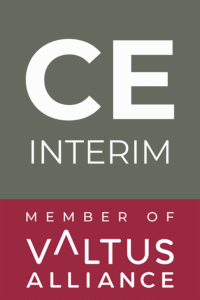Not enough time to read the full article? Listen to the summary in 2 minutes.
Navigating post-merger integration (PMI) can be a daunting task for any organization aiming to maximize synergies and boost operational efficiency after an acquisition. The process involves adjusting strategies, cultures, and operations between merging entities—a complex challenge that requires careful planning and execution.
Effective post-merger integration strategies include comprehensive preparation, cultural sensitivity, and proactive change management. Without these key elements, organizations often struggle with displacement and inefficiency, risking the success of the merger.
Learn how CE Interim’s guide & services aid seamless post-merger integration success for your organization.
What is Post-Merger Integration?
Post-merger integration (PMI) refers to the process of combining two or more companies after a merger or acquisition to achieve connections, streamline operations, and maximize financial performance. It involves organizing structures, cultures, processes, and systems to ensure a seamless transition and to capitalize on strategic objectives.
Objectives and Benefits of Post-Merger Integration
Effective post merger integration (PMI) is crucial for the success of any merger or acquisition. It involves a comprehensive strategy to combine the operations, cultures, and systems of the merging entities, ensuring that the anticipated benefits and synergies are realized.
Understanding the goals and benefits of PMI can help organizations navigate this complex process more effectively, leading to long-term success and stability.
Goals of Post Merger Integration:
- Operational Synergy: Achieving operational efficiencies by integrating systems, processes, and technologies. This includes creating a unified IT infrastructure, simplifying supply chains, and consolidating administrative functions.
- Cultural Alignment: Aligning the values, mission, and work culture of the merging entities to foster a cohesive work environment. This is essential for long-term success and employee satisfaction.
- Financial Performance: Enhancing financial performance through cost reductions and revenue growth. Identifying and eliminating redundancies, optimizing resource allocation, and using cross-selling opportunities are key strategies.
- Retention of Key Talent: Retaining top talent to maintain business continuity and leverage the expertise within the organization. Engaging and retaining key employees is a critical component of a successful PMI plan.
- Customer Retention and Satisfaction: Maintaining and enhancing customer relationships to ensure minimal disruption to customer service. Improving the customer experience through the combined entity’s enhanced capabilities is crucial.
- Regulatory Compliance: Ensuring compliance with all relevant regulations and legal requirements. Harmonizing policies and procedures to meet industry standards and legal obligations across different jurisdictions is fundamental.
Benefits of Post Merger Integration:
- Increased Market Share: Enhancing the competitive positioning of the combined entity, leading to an increased market share through expanded product offerings, access to new markets, and strengthened market presence.
- Cost Savings: Achieving cost efficiencies through economies of scale. Consolidating operations, reducing duplicate roles, and optimizing supply chains contribute to significant cost savings.
- Enhanced Innovation: Fostering innovation by integrating diverse teams and resources. Combining different perspectives and expertise drives product development and improves service offerings.
- Revenue Growth: Unlocking new revenue streams by using the strengths and capabilities of both organizations. Cross-selling opportunities, new customer segments, and wider geographic reach contribute to revenue growth.
- Stronger Financial Position: Enjoying a stronger financial position with increased access to capital markets and improved creditworthiness. This financial strength can be leveraged for further strategic investments and growth initiatives.
- Improved Efficiency: Streamlining operations and integrating best practices lead to improved operational efficiency. Faster decision-making, reduced operational costs, and enhanced overall productivity result from this process.
- Risk Mitigation: Mitigating risks associated with market fluctuations and economic downturns by diversifying products, services, and markets. This diversification enhances the resilience and stability of the organization.
Factors Influencing Post-Merger Integration
Post merger integration (PMI) success is influenced by various factors that determine whether the newly formed entity can achieve its strategic objectives and realize synergies. Understanding these factors is essential for business leaders and stakeholders to navigate the complexities of merging operations, cultures, and systems.
The ability to effectively manage these elements can significantly impact the long-term growth and stability of the merged organization.
Elements of Successful Integration:
- Strategic Alignment: Ensuring that both organizations have a shared vision and strategic objectives is crucial for maintaining focus and direction during the integration process.
- Comprehensive Planning: A detailed post merger integration plan with clear timelines, milestones, and resource allocation acts as a roadmap for effective integration.
- Effective Leadership: Strong leadership is essential for making decisive actions, facilitating effective communication, and motivating employees through the transition.
- Clear Communication: Open and transparent communication helps manage expectations, reduce uncertainties, and build trust among stakeholders.
- Cultural Integration: Assessing and blending the corporate cultures of both entities promote a unified organizational identity and smooth operational integration.
- Change Management: Addressing employee concerns and managing resistance through change management strategies ensure a smoother transition.
- Financial Due Diligence: Thorough financial analysis and due diligence help identify potential risks and synergies, aligning financial integration with strategic goals.
- Technological Integration: Harmonizing IT systems, data, and processes is essential for operational efficiency and robust cybersecurity.
- Legal and Regulatory Compliance: Navigating legal and regulatory requirements ensures that governance structures are aligned and local regulations are adhered to, avoiding potential pitfalls.
Impact on Business Growth and Stability:
- Enhanced Market Reach: Combining customer bases and distribution networks expands market presence, increasing market share and revenue growth.
- Operational Synergies: Streamlining operations and optimizing resources can lead to significant cost savings and enhanced operational efficiency.
- Innovation and Product Development: Integrating diverse skills and technologies fosters innovation, leading to new products and services that drive competitive advantage.
- Financial Performance: Successful PMI improves financial performance through economies of scale, enhanced revenue streams, and cost reductions.
- Risk Diversification: Spreading operational and market risks across a broader portfolio enhances business stability and resilience.
- Employee Retention and Morale: Effective integration strategies that address cultural and change management issues lead to higher employee retention and morale.
- Customer Satisfaction: Integrating customer service functions and aligning product offerings enhance the overall customer experience, leading to sustained revenue growth.
- Sustainable Growth: Strategic alignment and operational efficiencies contribute to sustainable long-term growth, positioning the merged entity to navigate market challenges and capitalize on opportunities.
The Role of CE Interim in Post-Merger Integration
In the complex world of post-merger integration, CE Interim stands out with its unique expertise in Cross-Cultural Executive Interim Management. Our approach combines rapid deployment and deep cultural understanding to ensure seamless integration and operational excellence.
Overview of CE Interim’s Services:
- Expertise in Cross-Cultural Executive Interim Management: We empower companies with leaders to navigate critical business transformations, leveraging over a decade of experience in multicultural markets.
- Rapid Deployment and Immediate Impact: We provide interim managers, industry experts, and advisory board members tailored to your needs within 72 hours, ensuring no downtime and swift progress.
- Seamless Integration of Local and Group Cultures: Our interim managers excel at harmonizing local and corporate cultures, ensuring effective collaboration and alignment with your company’s values and goals.
- Sector-Specific Knowledge and Functional Fit: We bring deep industry knowledge and ensure a perfect functional fit, making an immediate impact on your critical projects.
Post Merger Integration Services:
- Harmonization of Corporate Culture
- Implementation of Governance and Compliance
- Turnaround and Transformation Management
Choosing CE Interim ensures your organization benefits from experienced professionals who bring both local insights and international expertise, driving successful outcomes in post-merger integration.
Conclusion
Post-merger integration is a complex but crucial process for achieving the strategic goals behind mergers and acquisitions. By understanding the objectives, benefits, and factors influencing successful PMI, organizations can navigate this challenging terrain more effectively.
CE Interim’s expertise ensures seamless integration for long-term growth and stability post-merger.





